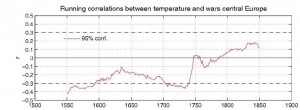A short piece in the latest Economist describes a paper in Climate Change on the historical correlation between temperature and war. Up to about 1740-1750 colder years were also more warlike years, at least in Europe (the authors quote a paper that suggests there’s a similar correlation for China). This correlation is never particularly strong, though it is occasionally statistically significant, but then it breaks down entirely and shoots up into very slightly positive (though non-significant) territory.

Dr Tol and Dr Wagner suggest that in the more remote past the effects of cold weather on harvests led to supply shortages, and that these increased the likelihood of people fighting over food and the land needed to produce it. They argue that the reason the relationship between warfare and cold vanishes in the mid-18th century is that this is the moment when the industrial revolution began. Both agriculture and transport improved rapidly at this time. Systematic plant breeding, the introduction of new crops and new forms of crop rotation, and better irrigation increased the food supply. Improvements in roads and the large-scale construction of canals allowed food to be transported from areas of plenty to areas of scarcity.
Does this have implications for the future? Presumably, it implies that we need not worry about war breaking out in Europe due to climate change. Not so fast.
Just because cold, rather than heat, caused problems in Europe during the millennium that Dr Tol and Dr Wagner examined does not mean rising temperatures pose no threat. The lesson, rather, is that the way to minimise the likelihood of climate-induced conflict in the future is to continue the process of crop improvement (for example, by taking advantage of the potential of genetic engineering) so that heat- and drought-tolerant varieties are available; to make farmers aware of these new crops and encourage their use; and to promote free trade and non-agricultural economic development. That way people will have no cause to fight, and tyrants no excuse to stir them up.
There is no correlation in this dataset between precipitation and war, but that’s the one I’d be watching.

